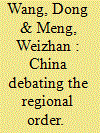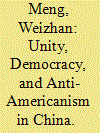|
|
|
Sort Order |
|
|
|
Items / Page
|
|
|
|
|
|
|
| Srl | Item |
| 1 |
ID:
172123


|
|
|
|
|
| Summary/Abstract |
This article examines China’s academic debates on the regional order in Asia since 2012, by surveying nine thematic issues. Those thematic issues are not exhaustive, yet they provide an overview of China’s intellectual landscape on the key issue of the regional order in Asia. This study shows that the United States (US) might have exaggerated China’s strategic intention. Rather than aiming to replace US hegemony with a Chinese-led Tianxia/tributary system in the region, Chinese scholars advocate mutual accommodation between China and the US.
|
|
|
|
|
|
|
|
|
|
|
|
|
|
|
|
| 2 |
ID:
188665


|
|
|
|
|
| Summary/Abstract |
The rise of China and how other countries respond to China’s rising is widely studied. But little has been done on how other countries reacted to the rise of China throughout history and how China strategically interacted with them. The conventional wisdom holds East Asian international relations did not operate in the Westphalian way and China’s rising in history did not trigger regional balancing actions. In this article, we challenge that view. We argue East Asian international relations were not exceptional to basic rules of the Westphalian system. Each time China rose up, it triggered balancing actions from neighboring regimes, including nomadic empires and settled kingdoms. The neighboring regimes would accommodate China only after they were defeated by China or pro-China regimes propped up in these countries. The Chinese hegemony in East Asian history could not be taken for granted. Over last 2,000 plus years, only during three periods of time (the Qin-Han 秦汉, Sui-Tang 隋唐, and Ming-Qing 明清 dynasties) China could successfully overpower regional resistance and enjoyed a stable tributary relationship with neighboring states. In the rest of time, the Chinese state could not retain hegemony in East Asia.
|
|
|
|
|
|
|
|
|
|
|
|
|
|
|
|
| 3 |
ID:
169192


|
|
|
|
|
| Summary/Abstract |
Many American scholars and pundits have recently concluded that the United States’ 40-year engagement strategy has failed to guide China to embark on the path of liberal democracy. Therefore, some scholars suggest that the United States separate itself from China, possibly through a policy of economic “disengagement,” or perhaps return to the containment policy.1 Such policies, however, could backfire and would not be conducive to China’s interests or to those of the United States and the Western world. It is still entirely possible for the United States to facilitate China on a path toward further political diversification, economic liberalization, integration with the Western world, and compliance with international rules.
|
|
|
|
|
|
|
|
|
|
|
|
|
|
|
|
| 4 |
ID:
174403


|
|
|
|
|
| Summary/Abstract |
The US-China relationship defines geopolitics in the 21st century. Despite a messy start, the Trump administration was able to provide a new national security strategy within the first year in office. The new US national security strategy clearly defines China as a strategic rival that "challenges American power, influence, and interests, attempting to erode American security and prosperity." For the first time, the United States outlined an Indo-Pacific strategy to compete with and contain China's rising power and influence among those countries along the Indian and Pacific oceans. As part of an overall competitive strategy vis-à-vis China, US Secretary of State Mike Pompeo called for "a new alliance of democracies" against China in the international community. The Chinese government has yet to officially respond to the US Indo-Pacific strategy as well as the "free and open Indo-Pacific" concept. Ten years ago, when the Obama administration rolled out the "pivot to Asia" strategy, Beijing's answer was a grand geoeconomic plan to expand Chinese economic power along the ancient Silk Roads on land and sea. Ten years later, how will Beijing respond to the new strategic challenge from Washington? In this article, the authors argue that Beijing has not taken tit-for-tat action to respond to the US Indo-Pacific Strategy. Instead, China has responded to the new American challenge in a more constructive, peaceful, and nonconfrontational manner. Beijing's objective is to mitigate possible national security risks while continuing to extend its international influence in the Indo-Pacific region and beyond.
|
|
|
|
|
|
|
|
|
|
|
|
|
|
|
|
|
|
|
|
|